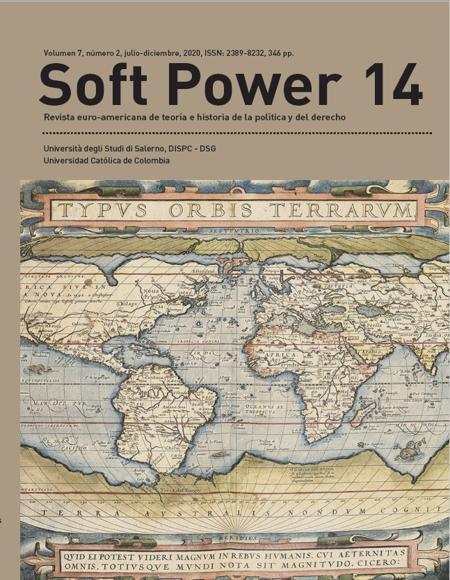
Esta obra está bajo una licencia internacional Creative Commons Atribución-NoComercial 4.0.
Al enviar los artículos para su evaluación, los autores aceptan que transfieren los derechos de publicación a Soft Power. Revista Soft Power para su publicación en cualquier medio. Con el fin de aumentar su visibilidad, los documentos se envían a bases de datos y sistemas de indización, así mismo pueden ser consultados en la página web de la Revista.Resumen
Una nueva forma de analizar la política internacional, utilizando un enfoque cualitativo, para evitar la alternancia entre la guerra y la paz, y fomentar el establecimiento de condiciones estables de paz mediante la construcción de identidades comunes en contextos regionales más amplios.

Citas
Adelman, I. and Hihn, J. M. (1982). Politics in Latin America: A Catastrophe Theory
Model. Journal of Conflict Resolution, 24(4), 592-620.
Buzan, B. (1993). Rethinking System and Structure. In B. Buzan, Ch. Jones, and R. Little,
The logic of Anarchy: Neorealism to Structural Realism (pp. 19-80). New York: Columbia
University Press.
Dockery, J. and Chiatti, S. (1986). Application of catastrophe theory to problems of military
analysis. In European Journal of Operational Research, 24(1), 46-53.
Flay, B. (1978). Catastrophe theory and the Study of War. In Journal of Conflict Resolution,
(2), 171-208.
Holt, R. and Brian, J. (1978). Catastrophe Theory. Selected Papers 1972-1977. Boston:
Addison-Wesley Pub. Co.
Isnard, C. A. and Zeeman, E. C. (1976). Some Models from Catastrophe Theory in Social
Sciences. In L. Collins (Ed.), The Use of Models in the Social Sciences (pp. 44-100).
London: Routledge.
Maldonado, C. (2006). Teoría de las catástrofes y teoría financiera. Odeón, (2), 56-74.
Mathews, M., White, M and Long, R. (1999). Why Study the Complexity Sciences in the
Social Sciences? Human Relations, 52(4), 439-462.
Oliva, T., Peters, M., and Murthy, H. S. K. (1981). A preliminary empirical test of a cusp
catastrophe model in the social sciences. Behavioral Science, 26(2), 152-162.
Prigogine, I. (1993). Le leggi del caos. Bari: Laterza.
Richardson, L. (1960). Statistics of deadly quarrels. New York: Boxwood Press.
Rosenau, J. (1990). Turbulence in World Politics. A Theory of Change and Continuity.
Princeton: Princeton University Press.
Saaty, T. (1996). Decision making with Dependence and Feedback: the Analytic Network
Process. Pittsburgh: RWS Publications.
Scartezzini, R. e Rosa, P. (1994). Le relazioni internazionali. Lineamenti di indagine sociologica.
Roma: Nuova Italia Scientifica.
Schubert, G. (1989). Catastrophe theory, evolutionary extinction, and revolutionary politics.
Journal of Social and Biological Structures, 12(2-3), 259-279.
Snyder, G. (1997). Alliance Politics. New York: Cornell University Press.
Thom, R. (1972). Stabilité structurelle et morphogénèse: essay d’une théorie générale des
modèles, Paris: Benjamin.
Thom, R. (1980). Modèles mathématiques de la morphogénèse. Paris : Bourgois.
Thom, R. (1993). Prédire n’est pas expliquer. Paris : Flammarion.
Varian, H. (1979). Catastrophe Theory and The Business Cycle. Economic Inquiry, 17(1),
-28.
Waltz, K. (1959). Man, the State and War: A Theoretical Analysis. New York: Columbia
University Press.
Waltz, K. (1979), Theory of International Politics, Newbery Award Records.
Zeeman, E. C. (1976), Catastrophe Theory, in Scientific American, vol. 234, n. 4, pp. 65-83.
Zeeman, E. C. (1978). Catastrophe Theory. Selected Papers 1972-1977. Reading, Addison-
Wesley (2nd Ed.).









